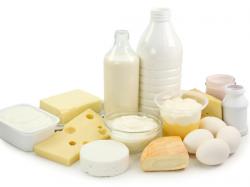The US Milk & Dairy Products Market Outlook To 2015
June 7, 2011 | 4 min to read

DUBLIN — Research and Markets has announced the addition of the "The US Milk and Dairy Products Market Outlook to 2015" report to their offering.
This report provides a comprehensive analysis of the milk and dairy products industry in the US. The report covers the total cow milk production, fluid milk consumption, segmentation on the basis of dairy products such as butter, cheese, skim milk powder, milk drinks and fermented products, cream, condensed milk and whey powder and volume of net trade for dairy products. It offers prevalent trends and developments in the industry, future opportunities and competitive landscape of the prominent players operating in the country. The report also includes information on the major macroeconomic indicators regressed for estimating the market for milk and dairy products in the US.
The US milk industry is 6th largest in the world in terms of cow milk production and represents more than 10% of the total milk production in the world in 2010. The cow milk production in the historical period increased at a CAGR of 1.0% during 2007-2009. The period registered an increase from 84,186 thousand tonnes in 2007 to 86,046 thousand tonnes in 2008. Milk production in the country is expected to register a marginal increase of 0.8% in the forecasted period from 2009-2015.
The fluid milk consumption decreased at a negative CAGR of 0.3% from 2007-2009. The decrease in the consumption was primarily because of the recession observed in 2009 which had a negative impact on the consumption. Considering the nature of the market which is saturated, the market is expected to grow slowly and will reach 28,721 thousand tonnes in 2015 from 27,700 thousand tonnes in 2009, registering a CAGR of 0.6%.
The milk cow numbers have registered a declining trend as compared to the increase in the milk production per cow. The milk production per cow has increased in both small and large farms as the less producing cows are removed from the herd and are being slaughtered for meat. In the near future, the milk cow numbers are further expected to decrease from 9,200 thousand in 2009 to 8,899 thousand in 2015. Meanwhile the production per cow will increase from 9,331 kilograms in 2009 to 10,141 kilograms in 2015, an increase of 1.4%.
In 2007, the butter production stood at 699 thousand tonnes. The butter production registered a growth of 6.4% in 2008 and reached 744 thousand tonnes. The year 2009 witnessed a decline in the butter production by 4.8%. Although the economy has shown signs of recovery in 2010, the market is yet to showcase a growth in the production of butter.
Mozzarella was one of the major types of cheese produced in the US. Mozzarella is an Italian traditional specialty food product. It is usually made from cow or buffalo milk. In 2009, it accounted for 32.3% of the total cheese production in the US. Cheddar was the second largest type of cheese produced with of 31.7% followed by other American and other Italian cheese accounting for 9.8% and 9% of the total cheese produced.
The US skim milk powder has seen major boost in production in the wake of increased demand for this dairy product in the international market. The consumption level on the other hand, has witnessed stable incline in the past due to several macro economic factors such as population growth and increased median household income playing a subdued role in the market. It is expected this consolidation will be fleeting and the market will get back on its long term trend demand growth in the near term.
Global demand and supply gap in the milk and dairy products will present several internal and external growth opportunities for the US. The US milk and dairy market is currently well positioned to serve the milk supply shortage in the world and has prospects to increase its market share in the exports to other countries. There are two kind of external growth opportunities available to the US dairy exporters, first, to increase its share in the import demand growth in the regions where the economy is highly integrated with the customer market such as Mexico and second; to encapsulate the latent demand gaps for dairy products that will arise across the rest of the global market.
Key Topics Covered:
1. US Milk Market Introduction
1.1. US Cow Milk Market Production and Fluid Milk Consumption by Volume, 2007-2015
1.2. US Milk Cow Numbers and Milk Production per Cow, 2007-2015
2. US Dairy Products Market Introduction
2.1. US Dairy Products Market Production by Volume, 2007-2015
2.2. US Dairy Product Market Consumption by Volume, 2007-2015
2.3. US Dairy Product Market Net Trade by Volume, 2007-2015
3. Trends and Developments in US Milk and Dairy Products Market
4. US Milk and Dairy Products Market Future Outlook
5. Competitive Landscape
6. Macro Economic Indicators: Current and Projections
6.1. Population, 2007-2015
6.2. GDP, 2007-2015
6.3. Inflation, 2007-2015
6.4. Unemployment Rate as a % of Labour Force, 2007-2015
6.5. Demographic Distribution of Population on the basis of Age, 2009-2015
6.6. Personal Disposable Income and Number of Households in the US, 2009-2015
6.7. Distribution of Income among Households, 2009-2015
7. Appendix
Companies Mentioned:
•Kraft Foods
•Dean Foods
•DFA
•Land O' Lakes
•Schreiber
For more information visit http://www.researchandmarkets.com/research/7f1a46/the_us_milk_and_da
Source: Research and Markets
